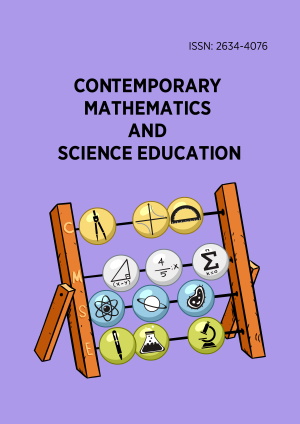Research Article
Assessing Nigerian Secondary School Students’ Misconceptions in Five Basic Statistical Concepts
More Detail
1 Department of Curriculum and Instructional Technology, Faculty of Education, University of Benin, Benin City, NIGERIA* Corresponding Author
Contemporary Mathematics and Science Education, 1(1), January 2020, ep20003, https://doi.org/10.30935/conmaths/8448
Published: 01 August 2020
OPEN ACCESS 2440 Views 1824 Downloads
ABSTRACT
The study was designed to assess and document students’ right conceptions and misconceptions of five basic concepts in statistics. It employed the survey design to randomly select 4332 participants from 114 Senior Secondary Schools across Edo State, Nigeria. The instrument was a two-tier multiple choice diagnostic test, which was validated and with a K-R Formular 20 reliability coefficient of 0.85. Three research questions were raised to guide the study. Data were analyzed using frequency counts and percentages. Results showed low students’ right conceptions of basic statistical concepts and with majority of students having some nine misconceptions. It was recommended that teachers and textbook writers should use conceptual change instructional strategies to identify and change students’ misconceptions in statistics in order to improve students’ understanding and achievement in mathematics.
CITATION (APA)
Idehen, F. O. (2020). Assessing Nigerian Secondary School Students’ Misconceptions in Five Basic Statistical Concepts. Contemporary Mathematics and Science Education, 1(1), ep20003. https://doi.org/10.30935/conmaths/8448
REFERENCES
- Cakir, M. (2008). Constructivist approaches to learning in science and their applications for science pedagogy: a literature review. International journal of environmental and science education, 3(4), 193- 206. Retrieved from https://files.eric.ed.gov/fulltext/EJ894860.pdf
- Chandrasegran, A. L., Treagust, D. F., & Mocerino, M. (2007). The development of a two-tier multiple-choice diagnostic instrument for evaluating secondary school students’ ability to describe and explain chemical reactions using multiple levels of representation. Chemistry education research and practice, 18(3), 293-307. https://doi.org/10.1039/B7RP90006F
- Doane, D., & Seward, L. (2007). Applied statistics in business and economics. Boston, MA: McGraw-Hill Irwin. Retrieved from https://www.amazon.com/Statistics-Business-Economics-Mcgraw-hill-Operations/dp/0073373699
- Ebisine, S. S. (2010). Difficulties encountered by senior secondary school students in understanding of non-technical words in mathematics multiple-choice tests. Abacus, The Journal of Mathematical association of Nigeria, 35 (1), 97-105.
- Federal Ministry of Education (1979). Senior secondary school mathematics curriculum. Lagos: Federal Ministry of Education.
- Federal Ministry of Education (2007a). 9-year basic education curriculum: mathematics primary 1-3. Abuja: Nigerian Educational Research and Development Council (NERDC).
- Federal Ministry of Education (2007b). Senior secondary education curriculum: mathematics for JS 1-3. Abuja: Nigerian Educational Research and Development Council (NERDC).
- Federal Ministry of Education (2007c). Nigeria Certificate in Education (NCE) course book on mathematics, year 1. Kaduna: National Teachers Institute.
- Idehen, F. O. (2011). An assessment of secondary school students’ conception of selected mathematical concepts in Edo State (Unpublished Ph.D thesis), Faculty of Education, University of Benin, Benin City. Retrieved from https://www.iwemi.com/an-assessment-of-secondary-school-students-conceptions-of-selected-mathematical-concepts-in-edo-state
- Ishaku, A., & Idris, M. (2017). Analysis of perceived difficult topics by primary school mathematics teachers and pupils in Dutsin-Ma, Katsina State. Abacus, Journal of the Mathematical Association of Nigeria (MAN), 42(1), 164-177. Retrieved from https://www.man-nigeria.org.ng/abstract?sid=ABA-EDU-2017-1-17
- Oliveira Junior, A. P., Zamora, P. R., Azevedo de Oliveira, L., & Costa de Souza, T. (2018). Students’ attitudes towards probability and statistics on higher education. Acts Didactica Napocensia, 11(2), 43-56. https://doi.org/10.24193/adn.11.2.4
- Reaburn, R. (2011). Students’ understanding of statistical inference: implications for teaching (Ph.D. Thesis), University of Tasmania, Australia. Retrieved from https://iase-web.org/documents/dissertations/11.RobynReaburn.Dissertation.pdf
- Saidi, S. S., & Siew, N. W. (2918). Assessing students’ understanding of the measures of central tendency and attitude towards statistics in rural secondary schools. International Electronic journal of Mathematics Education, 14(1), 73-86. Retrieved from https://files.eric.ed.gov/fulltext/EJ1227361.pdf
- Tan, K. C. D., Taber, K. S., Goh, N. K., & Chia, L. S. (2005). The ionisation energy diagnostic instrument: a two-tier multiple-choice instrument to determine high school students’ understanding of ionisation energy. Chemistry Education Research and Practice, 6(4), 180-197. https://doi.org/10.1039/B5RP90009C

 The articles published in this journal are licensed under the CC-BY Creative Commons Attribution International License.
The articles published in this journal are licensed under the CC-BY Creative Commons Attribution International License.